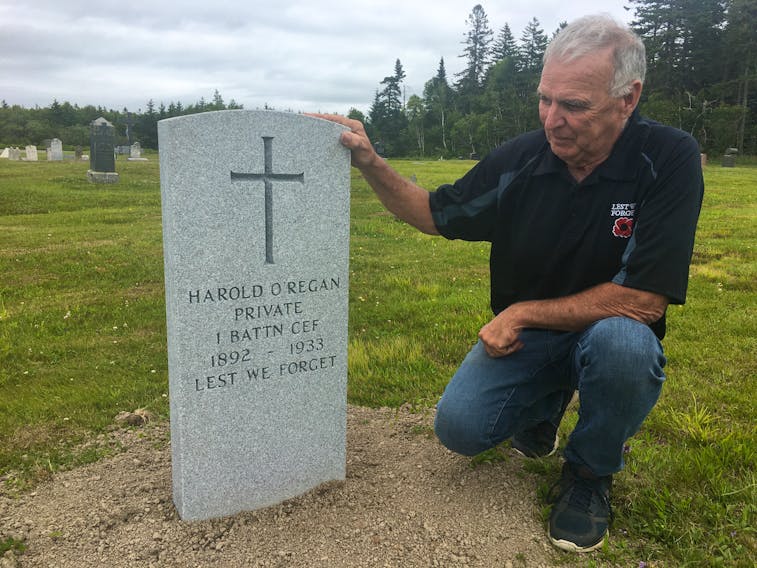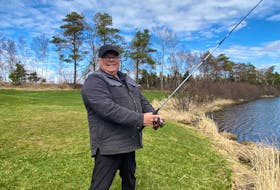JOGGINS, N.S. — Two years ago Dean Brown and his wife were metal detecting on the beach at Lower Cove when they found a medal belonging to First World War veteran Pte. Harold O’Regan.
Now, with the assistance of the Last Post Fund, O’Regan’s grave in the cemetery at nearby Ragged Reef is marked with a new headstone recognizing his service than a century ago to King and Country.

“It’s a fitting end to the story,” Dara Legere of the Joggins branch of the Royal Canadian Legion said. “The headstone replaces a small metal cross that was at the gravesite and it recognizes he was a war veteran. He’s a piece of Joggins war history and it’s nice to see him recognized.”
Legere said it was fitting the medal was found on the 100th anniversary of the end of the war and the legion felt something should be done to mark his service. With no family in the area to do the leg work, Legere contacted the Last Post Fund to set the wheels in motion to have a new headstone placed at Ragged Reef.
“It’s something we felt we had to do,” Legere said. “With the 100th anniversary of the end of the war, it’s almost like it was meant to be.”
O’Regan enlisted in February 1916 and was sent to England for training before being dispatched to France following the Battle of Vimy Ridge.
He was originally a member of the 193rd Battalion before being moved to the Fourth Pioneer Battalion that would have been put to work digging tunnels, laying telephone wires, and other jobs.
It was ironic that O’Regan, like many young Joggins men, enlisted to escape the coal mines only to be put to work underground digging tunnels.
Legere, the legion branch’s vice-president and secretary, could not find what battles he would have participated in, but his arrival in France after Vimy coincided with the fight for Arras and the 100 Day Offensive at Amiens and Cambrai that helped turn the tide and lead to the German surrender in November 1918.
O’Regan remained in France until 1919, making his way back to Nova Scotia, via England, arriving in Halifax in May of that year. He would return to Joggins and go to work in the mines, become injured in a mining accident on Feb. 21, 1933. He died on March 13.
“A veteran to us doesn’t mean they had to have served in World War One, World War Two or Korea. A veteran to us is someone who did their basic training. We want to increase awareness that there are a lot of veterans out there whose family don’t think they qualify.”
A HEADSTONE FOR EVERY VETERAN
Steve St-Amant represents the Last Post Fund in Nova Scotia. He said O’Regan’s story is an example of the work the organization is doing across Canada to make sure every veteran has a headstone on his or her grave.
He estimates there could be as many as 5,000 unmarked veterans graves across the country. In Nova Scotia, approximately 13 graves are identified every year. He would like to see that number increase.
“I believe there are a lot of unmarked graves out there,” St-Amant said.
Created in 1909, the Last Post Fund is a non-profit organization with the mission to ensure no veteran is denied a dignified funeral and burial as well as a military gravestone due to insufficient funds.
He said the organization is trying to raise its profile and let veterans’ families know they can get assistance.
“We’re happy to provide headstones free of charge to families that have unmarked graves of veterans,” he said. “A veteran to us doesn’t mean they had to have served in World War One, World War Two or Korea. A veteran to us is someone who did their basic training.
“We want to increase awareness that there are a lot of veterans out there whose family don’t think they qualify.”
St-Amant said there are many service people who didn’t think they would qualify because they didn’t serve in a war.
To get more information on the program, St-Amant can be contacted at [email protected].
Legere is happy to see O’Regan’s memory rekindled a century after the war ended, but the story would be happier if a family member could be found.









